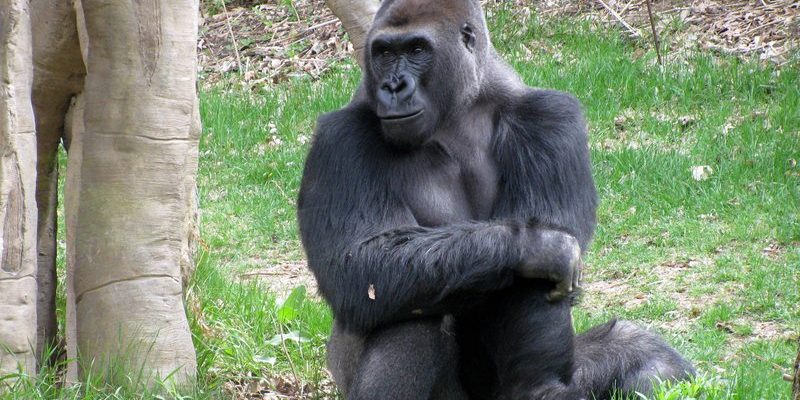
Encountering an Eastern gorilla could be one of the most awe-inspiring moments of your life. Just imagine standing in a lush green jungle, surrounded by the sounds of nature, when suddenly, a massive gorilla steps into view. Your heart races, and you feel a mix of excitement and trepidation. But here’s the thing: knowing how to handle this situation is essential. In this guide, we’ll explore what to do if you encounter an Eastern gorilla in the wild, offering you practical advice and insights to ensure a safe and memorable experience.
Understanding Eastern Gorillas
Eastern gorillas, specifically the Eastern lowland gorilla and the mountain gorilla, are unique creatures that inhabit different environments within Africa. The Eastern lowland gorilla thrives in the dense, lowland forests, while the mountain gorilla makes its home in the rugged mountainous regions. Both subspecies are critically endangered, primarily due to habitat loss and poaching. This makes every encounter not only a gift but also a moment of accountability for conservation.
Gorillas are known for their strong social structures and family bonds. Living in groups called troops, they exhibit fascinating behaviors, including grooming each other and playing with their young. These interactions can paint a vivid picture of their lives, showcasing their intelligence and emotional depth. If you’re lucky enough to observe this, it’s not just an encounter; it’s a window into the complex world of these magnificent beings.
When you spot an Eastern gorilla in the wild, understanding their body language is key. Gorillas communicate through various gestures and vocalizations, which can signal everything from curiosity to aggression. Here are some signs to look out for:
- Chests thumping: This is usually a display of confidence or a warning. It’s best not to approach during this behavior.
- Vocalizations: Gorillas may grunt or roar to communicate. Pay attention to the tone and context.
- Posturing: If a gorilla stands tall and displays its teeth, it may feel threatened.
Understanding these cues will help you gauge the gorilla’s mood and determine your next steps.
Stay Calm and Assess the Situation
If you find yourself in the presence of an Eastern gorilla, your first instinct might be to panic. Honestly, that’s totally normal! But here’s the thing: staying calm is crucial. Gorillas can sense fear or anxiety, which may lead them to feel threatened. Take a moment to breathe, assess the situation, and observe the gorilla from a safe distance.
You should also consider your surroundings. Are there other gorillas nearby? Is the gorilla alone, or is it with a troop? Understanding the dynamics of the situation can help you decide how to proceed. If there are baby gorillas present, exercise extra caution, as the mother gorilla may become protective.
While observing, keep your movements slow and deliberate. Sudden actions can startle the gorilla, leading to an unpredictable response. If the gorilla seems relaxed, you might have a moment to appreciate the beauty of this magnificent animal. But don’t linger too long—it’s important to respect their space.
Maintain a Safe Distance
When encountering an Eastern gorilla, maintaining a safe distance is one of the most critical things you can do. You might be tempted to get closer for a better view or a photo, but remember that these animals are wild. The recommended distance is at least 20-30 feet. This distance allows you to observe without invading their space.
Gorillas are strong and can move quickly if they feel threatened. If you’re too close, you may provoke an aggressive response. It’s a little like watching a live performance; you want to enjoy the show without getting on stage. Factor in your safety, and be considerate of their habitat.
Using binoculars or a zoom lens can enhance your experience without compromising safety. This way, you can enjoy the details of their behavior, expressions, and interactions without encroaching on their territory.
What To Do if a Gorilla Approaches You
Encountering an Eastern gorilla that approaches you can be both thrilling and intimidating. First, don’t panic! Remember that gorillas are often more curious than aggressive. They may approach out of interest rather than a threat. Stand still and avoid making sudden movements or loud noises.
Let me explain how to react if a gorilla moves closer. Your primary goal is to appear non-threatening. Here are some tips:
- Lower your gaze: Looking directly at a gorilla can be seen as a challenge. Instead, look down or to the side.
- Remain silent: Try not to talk or make loud noises; this helps to keep the environment calm.
- Don’t run: If a gorilla approaches you, running can trigger a chase response. Stay put and remain as calm as possible.
Gorillas may also bluff—showing their strength without intending to attack. If you observe this, maintain your peaceful demeanor and give them space.
Know When To Leave the Area
Sometimes, the best option is to simply back away and leave the area. If a gorilla seems agitated or starts displaying aggressive behavior, it’s a smart move to give them more space. You might be wondering how to tell when it’s time to leave.
Look for signs such as:
- Aggressive posturing: If the gorilla stands tall and beats its chest, that’s a clear warning.
- Group dynamics: If other gorillas in the vicinity are becoming tense, it’s a sign to exit.
- Vocalizations: Listen to the sounds they make. Growling or loud, sharp vocalizations can indicate a need to retreat.
When it’s time to leave, do so slowly and cautiously. Avoid turning your back on the gorilla and keep your movements gradual. This way, you help ensure both your safety and the well-being of the gorillas.
Respect the Habitat and Conservation Efforts
Encountering an Eastern gorilla isn’t just about the moment; it’s also about the broader context of wildlife conservation. These incredible creatures are facing significant threats due to habitat loss, poaching, and disease. By respecting their habitat and supporting conservation efforts, you play a vital role in ensuring future generations can experience these magnificent animals.
When visiting regions where Eastern gorillas live, follow local guidelines and regulations. Here are some ways you can contribute:
- Support eco-friendly tourism: Choose tours and guides that prioritize conservation efforts.
- Educate others: Share your knowledge about Eastern gorillas and the challenges they face.
- DONATE: Consider donating to organizations that focus on gorilla conservation and habitat protection.
By being a responsible visitor, you not only enrich your own experience but also aid in the long-term survival of these amazing animals.
Closing Thoughts
Encountering an Eastern gorilla in the wild can be a breathtaking experience, but it comes with great responsibility. Remember to stay calm, respect their space, and be mindful of your surroundings. By understanding these gentle giants and handling the situation appropriately, you become part of their story—a story worth preserving for generations to come.
So, the next time you find yourself in the wild and spot one of these majestic creatures, know that you have the tools to appreciate the moment while ensuring everyone’s safety. Enjoy your adventures in nature, and cherish the remarkable connections we share with wildlife.

